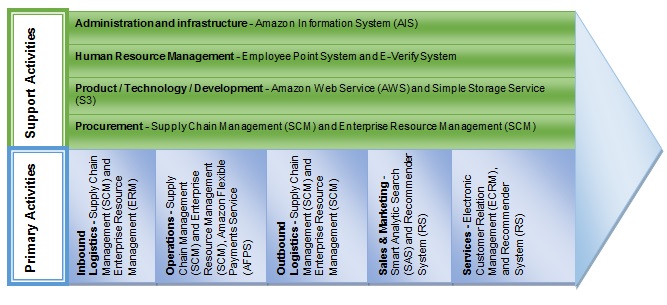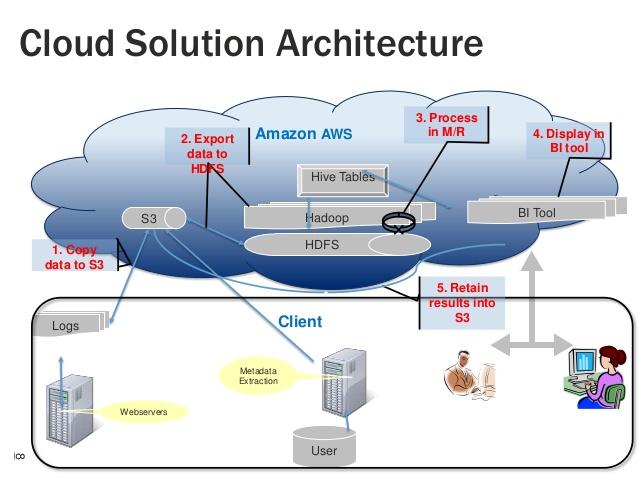Background into Amazon and Information Systems Utilized
Amazon is a global online retailer, which has dominated virtually every market across the world. It started in 1994 as an online bookstore in Seattle, Washington, which is the current headquarters. Owing to the emergence of information technology in the 21st century, Amazon has incorporated numerous information systems into its value chain. Amazon has adopted Michael Porter’s value chain model, which enables it to create new products and improve retail performance to remain competitive in the online platform. The information systems that form the backbone of the value chain model are Amazon Web Service (AWS) and Simple Storage Service (S3). These information systems loosely integrate with other information systems such as Smart Analytic Search (SAS), Recommender System (RS), Electronic Customer Relation Management (ECRM), Supply Chain Management (SCM), Enterprise Resource Management (ERM), Employee Point System (EPS), Amazon Information System (AIS), and Amazon Flexible Payments Service (AFPS). This research paper will describe the role of each of the information systems in the value chain model of Amazon Inc.
Amazon Value Chain and System

Primary Activities Overview
As an online retail store, Amazon applies information systems in its value chain model. In the primary activities, Amazon has integrated information systems in different aspects of the value chain, namely, inbound logistics, operations, outbound logistics, sales and marketing, and services. In logistics, Amazon has Supply Chain Management (SCM) and Enterprise Resource Management (ERM). SCM is a system that automates activities of supply chain and warehouse, and thus, increases efficiency of ordering supplies and interacting with suppliers. Given that Amazon does not want to store products, ERM is an automated customers’ ordering system, which is linked to the stock keeping unit so that Amazon can maintain its stock within appropriate limits. In the aspect of operations, Amazon employs SCM in sending automated requests to suppliers and ERM automates order requests of customers and links them to the nearest distribution center (Imran, 2014). Amazon also has Amazon Flexible Payment Service (AFPS), which enables customers to make secure payments efficiently.
In the aspect of outbound logistics, Amazon applies SCM and ERM. As customers make orders through ERM, which automates their requests, SCM transmits the same requests to suppliers. In this view, Amazon is able to make real-time order and supply of the required products to various distribution centers across the globe. To enhance its productivity, Amazon employs information systems in the aspect of sales and marketing. Smart Analytic Search (SAS) is an interactive searching system that enables customers to search products easily and allows Amazon to monitor their shopping behavior. Amazon uses Recommender System (RS) in giving customers appropriate and relevant information based on their shopping behavior. In the aspect of services, Amazon has Electronic Customer Relation Management (ECRM), which stores customers’ personal data such as profile information, transaction details, order record, and purchase history (Imran, 2014). This system aids customer care to resolve issues that customers present effectively. Amazon also uses RS in customer care because it enables customers to troubleshoot issues based on frequently asked questions.

Support Activities Overview
Amazon uses Amazon Information System (AIS) in the major management infrastructure that allows it to control its operations. In the recruitment of employees across the globe, Amazon uses E-Verify System (EVS) in determining eligibility of employees. Once recruited, Amazon uses Employee Point System (EPS) in monitoring performance of employees in the workplace. Regarding technological advancement, Amazon has two information systems, namely, Amazon Web Service (AWS) and Simple Storage Service (S3). AWS is an information system that Amazon employs in creating online platform, while S3 offers cloud computing, recovery, backup, and content distribution (Amazon, 2015). In the aspect of procurement, Amazon utilizes SCM and ERM in automating and synchronizing requests transmitted to suppliers and orders made by the customers.

Major Information Systems and Amazon Strategy
Supply Chain Management
In the aspect of primary activities, SCM is a major system that Amazon uses in its value chain. The main characteristics of the system are that it is automated, efficient, effective, and accurate in controlling supply chain. The role of the system is that it controls inbound logistics, operations, and outbound logistics automatically, and thus, enhance effectiveness and efficiency of retailing products. Another role of the system is that it allows customers to order products accurately and obtain them in time. Additionally, Amazon uses the system in placing orders automatically to suppliers, hence, replenishing stock, according to the orders made by customers. In essence, SCM enables Amazon to link suppliers and customers. The roles of the system are in line with Amazon e-business strategy of reaching millions of customers and supplying them with diverse products. In this view, SCM boosts e-business strategy by enabling Amazon to provide quality services and supply products in time as per the requests of customers, who are distributed globally, and consequently enhance its competitiveness in the online retail industry.
Simple Storage Service
Concerning support activities, Simple Storage Service (S3) is an information system that Amazon has integrated into its infrastructure. The main characteristics of the system are that it is secure, durable, scalable-memory, user-friendly, and compatible with other web-based applications (Amazon, 2015). S3 is secure because it provides for permission controls and encrypts data during transfer. Data stored in S3 is highly durable because it distributes among different devices and facilities in a redundant manner to reduce the risk of loss. S3 has a scalable memory, which allows Amazon to store any amount of data without any restrictions at favorably low cost. Concerning its user-friendly characteristic, S3 is simple and easy to use because it operates in mobile phones and personal computers. Its compatibility with web-based applications such as AWS enhances its functionality in the online retailing store. The major roles of S3 are data storage, distribution of data, recovery of data, and cloud computing. These roles enable S3 to align itself with the e-business strategy of supplying diverse products to millions of customers across the world via online stores. Specifically, S3 stores, transmits, and retrieves data of customers, suppliers, and products accurately, effectively, and efficiently, thus, promoting e-business strategy of Amazon.

References
Amazon: Amazon S3. (2015). Web.
Imran, A. (2014). A Study on Amazon: Information Systems, Business Strategies and E-CRM. Research Gate, 1(1), 1-13.